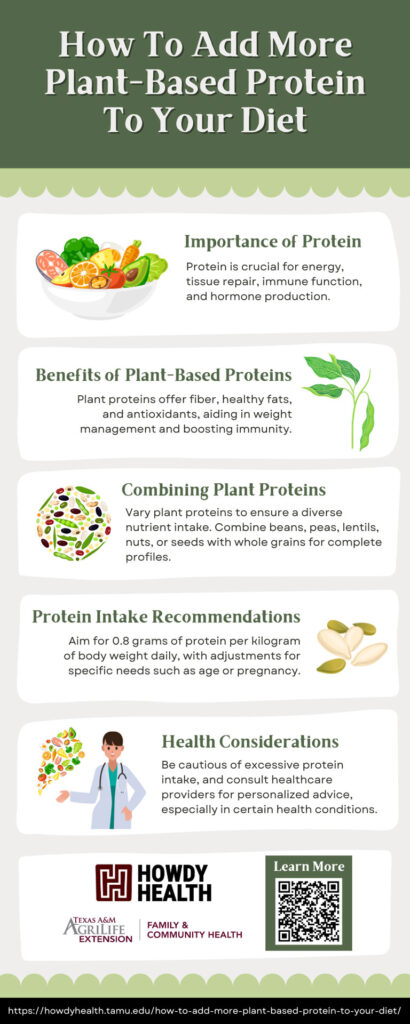Adding a variety of protein-rich foods in your diet is vital to your health. While we often think of protein coming from meat, poultry, and eggs, it’s also included in a variety of seafood and plant-based foods, such as beans, peas, lentils, nuts, and seeds. Plant-based proteins offer a wealth of benefits, providing an excellent alternative for those looking to diversify their protein sources.
Sometimes when people begin to add more plant foods to their diets, they may have concerns about getting all the recommended nutrients in the right amounts. Learning more about the vital functions of protein in the body and understanding how to combine different plant proteins to meet your protein needs can help you add plant-based proteins to your diet without any challenges.
Why Is Protein Important?
Protein is a macronutrient (along with carbohydrates and fat), that provides energy (four calories per gram) and hence it’s required in large (“macro”) amounts in the diet. Protein is made up of smaller units, called amino acids. There are 20 amino acids that combine in various sequences to form proteins. Nine of those amino acids, called essential amino acids, cannot be made by the body and need to be obtained from the diet.
Protein has several important functions in the body:
- It’s a major component of your muscles, bones, skin, hair, nails, and internal organs. It’s also found in almost all body fluids.1
- It’s essential for proper growth and development, including building, maintaining, and repairing tissues, cells, and organs throughout the body.1,2
- It plays a crucial role in many body processes, such as blood clotting, fluid balance, immune response, vision, and production of hormones, antibodies, and enzymes.1
Why Are Varied, Quality Plant-Based Proteins Important?
Not all plant-based proteins are the same. Plant proteins such as beans, nuts and seeds are high in dietary fiber and healthy fats that can help lower blood cholesterol levels and may aid in weight loss. Plant foods are also rich in antioxidants that contribute to enhanced immunity by preventing cell damage.
When choosing plant-based proteins, it’s important to choose a variety of them. In fact, varying your proteins to get more of the nutrients your body needs is a key component of the Dietary Guidelines for Americans and the MyPlate message.3,4
Protein foods are made up of different combinations of amino acids and are categorized as complete and incomplete proteins based on the total essential amino acids they provide.1
- Complete proteins contain all the essential amino acids in adequate amounts, meeting the body’s requirements for making protein. Although complete proteins are mostly found in animal products, soy and quinoa are two plant foods that offer complete proteins.
- Incomplete proteins lack one or more essential amino acids. Most plant foods are considered as incomplete proteins; however, by combining two or more incomplete plant protein sources at the same meal or during the same day, you can get a balanced set of all the essential amino acids that you need in a day.1 For example, grains (rice, wheat, and corn) are low in the amino acid lysine, while legumes (beans, peas, and nuts), are low in the amino acid methionine. When grains and legumes are eaten together (e.g. whole wheat bread with peanut butter), they form a complete protein.1
This is why it’s important to vary your proteins. By combining varieties of plant-based proteins, you can get the complete protein profile your body needs.
To make a complete protein, try these food combinations:
- Combine with whole grains: Eat beans, peas, lentils, nuts and/or seeds with whole grains – for example, red beans and brown rice, nuts and/or seeds atop barley, or peas and other veggies mixed with farro.
- Add to mixed dishes: Add beans, peas, or lentils to stir-fries, curries, kebabs, casseroles, and egg dishes for more variety. The nutrition in beans, dried peas, and lentils (also known as pulses) is comparable to both vegetables and protein foods, and hence they belong to both these food groups.
- As a spread: Have your favorite nut or seed butter (e.g., peanut butter, almond butter, sunflower seed butter, etc.) spread on a piece of whole grain bread – for example, peanut butter on whole wheat toast.
- As a dip or dressing: Use nut or seed butters as a dip for your vegetables. Some examples are avocado and black bean dip, roasted bell pepper and walnut dip, spicy edamame dip, and kale and cashew dip. Try using tahini (ground sesame seed paste) to make humus (flavored chickpea dip) or other vegetable dips, salad dressings, or stir it into soups or stews.
- As a topping: Add nuts or seeds atop your grits, oatmeal, cream of wheat, yogurt, stir-fries, salads, and other baked foods and desserts.
- As a healthy snack: Choose nuts and seeds as a snack – for example, make your own snack mix with roasted chickpeas, Greek yogurt topped with chia seeds, trial mix with dried fruits and nuts, and mixed nuts and seeds seasoned with spices like cumin, smoked paprika, turmeric, and/or garlic powder.
- Choose complete proteins often: Remember, both soy and quinoa are complete proteins. Make edamame (soybeans), tofu, or tempeh as your main source of protein in casseroles, pastas, or stir fries; or simply have a cold glass of soy milk. Make a protein powered bowl by serving quinoa topped with edamame, nuts, and roasted vegetables.
If some of the plant-based proteins are new to you, experiment with recipes, seasonings, and different combinations to find flavors you and your family enjoy.
In addition to variety, it’s also important to select proteins in nutrient-dense form. For example, canned beans are a good source of protein, but depending on the product you choose, they could have a high concentration of salt (sodium), saturated fat, or added sugar. It’s important to read the Nutrition Facts Label and ingredients list on packaging to know what you might be eating in addition to protein, as well as the amount of protein per serving.
How Much Protein Is Enough?
You may have heard that protein foods can help you feel fuller than carbohydrates and fats – and studies support this idea.7 Since protein digests (breaks down) more slowly than carbohydrates, protein can help us feel full longer.4 A feeling of fullness can help support weight loss and weight maintenance.
Does this mean you should eat more protein? Not necessarily. Most Americans eat the amount of protein they need – if not more. If we eat more protein than our bodies need, the body will break it down and store its components as fat4 – not what we want!
So how much protein do you need? The amount of protein you need depends on your age, sex, height, weight, and physical activity.5 According to the National Academy of Medicine, the Recommended Daily Allowance (RDA) for both men and women is 0.8 grams per kilogram of bodyweight.5 To calculate this, divide your weight in pounds by 2.2 to get your weight in kilograms, then multiply that weight (kg) by 0.8 to get the required amount of protein you should be eating each day.
You can also use the USDA DRI Calculator to find your daily protein numbers.
The National Academy of Medicine sets a wide range for acceptable protein intake—anywhere from 10% to 35% of calories each day.6,7 This is a recommendation to determine what percentage of a person’s daily calories (kcal) should come from protein sources.
For instance, if you are on a 2,000-calorie diet, your calories from protein intake should range between 200 and 700 calories, equivalent to 50 to 175 grams of protein per day (remember, each gram of protein provides four calories).
There are times when you may need more protein. Here’s a look at some of those times, and the reason why:
- Children need more protein proportional to their body weight than adults because they are growing.
- Women who are pregnant need more protein for maternal health and to support their growing baby.8
- Women who are lactating need more protein to maintain their own muscle mass, while also providing adequate nutrition to their infant through breast milk.9
- Older adults may need more protein to support good health, promote recovery from illness, and maintain functionality.10
- Adults who are trying to build muscle may need more protein in order to gain muscle mass.6,10
- Adults who are limiting calories to lose weight may need more protein to prevent muscle loss while they’re losing weight.4
Note: In certain conditions, protein consumption can be problematic – especially if consumed in excessive amounts. Two specific conditions where protein consumption can be problematic are renal insufficiency and kidney failure.6 Talk with your health care provider about your specific protein needs.
Remember…
When choosing proteins, choose quality sources without excess sodium, saturated fat, or added sugar. Choose a variety of plant-based proteins and combine protein sources for a complete protein profile. If you’re looking to diversify your proteins, plant-based proteins offer a wealth of benefits, and provide an excellent alternative or addition to your diet.
Interested in learning more about ways to take control of your health? Check out all our free Howdy Health programs to step into the habit of healthy.
Infographic
Download the PDF or share the image below to help others learn more about how to add more plant-based protein to their diet.
How to Add More Plant-Based Protein to Your Diet – Infographic (pdf)
- U.S. Food & Drug Administration. What it is – Food and Drug Administration. Accessed January 22, 2024. https://www.accessdata.fda.gov/scripts/InteractiveNutritionFactsLabel/assets/InteractiveNFL_Protein_October2021.pdf
- Robinson L. Choosing healthy protein. HelpGuide.org. January 2, 2024. Accessed January 19, 2024. https://www.helpguide.org/articles/healthy-eating/choosing-healthy-protein.htm.
- U.S. Department of Agriculture and U.S. Department of Health and Human Services. Dietary Guidelines for Americans, 2020-2025. 9th Edition. Accessed October 9, 2023. https://www.dietaryguidelines.gov/sites/default/files/2020-12/Dietary_Guidelines_for_Americans_2020-2025.pdf. 6. U.S. Department of Agriculture. MyPlate.gov. Accessed October 2, 2023. https://www.myplate.gov/.
- Bhupathiraju SN, Hu F. Carbohydrates, proteins, and fats – disorders of nutrition. Merck Manuals Consumer Version. December 6, 2023. Accessed January 19, 2024. https://www.merckmanuals.com/home/disorders-of-nutrition/overview-of-nutrition/carbohydrates,-proteins,-and-fats.
- Institute of Medicine 2005. Dietary reference intakes for energy, carbohydrate, fiber, fat, fatty acids, cholesterol, protein, and amino acids. The National Academies Press. Accessed January 19, 2024. https://nap.nationalacademies.org/read/10490/chapter/12#691.
- Manore MM. Exercise and the Institute of Medicine recommendations for nutrition. Curr Sports Med Rep. 2005 Aug;4(4):193-8. doi: 10.1097/01.csmr.0000306206.72186.00. PMID: 16004827
- Harvard University T.H. Chan School of Public Health. Protein. The Nutrition Source. October 19, 2023. Accessed January 22, 2024. https://www.hsph.harvard.edu/nutritionsource/what-should-you-eat/protein/#how-much-need.
- Gavin ML, ed. Pregnant or breastfeeding? nutrients you need (for parents) – nemours kidshealth. KidsHealth. October 2020. Accessed January 22, 2024. https://kidshealth.org/en/parents/moms-nutrients.html.
- Rasmussen B, Ennis M, Pencharz P, Ball R, Courtney-martin G, Elango R. Protein Requirements of Healthy Lactating Women Are Higher Than the Current Recommendations. Curr Dev Nutr. 2020 May 29;4(Suppl 2):653. doi: 10.1093/cdn/nzaa049_046.
- Bauer J, Biolo G, Cederholm T, Cesari M, Cruz-Jentoft AJ, Morley JE, Phillips S, Sieber C, Stehle P, Teta D, Visvanathan R, Volpi E, Boirie Y. Evidence-Based Recommendations for Optimal Dietary Protein Intake in Older People: A Position Paper From the PROT-AGE Study Group,Journa l of the American Medical Directors Association, Volume 14, Issue 8, 2013, Pages 542-559, ISSN 1525-8610, https://doi.org/10.1016/j.jamda.2013.05.021.






